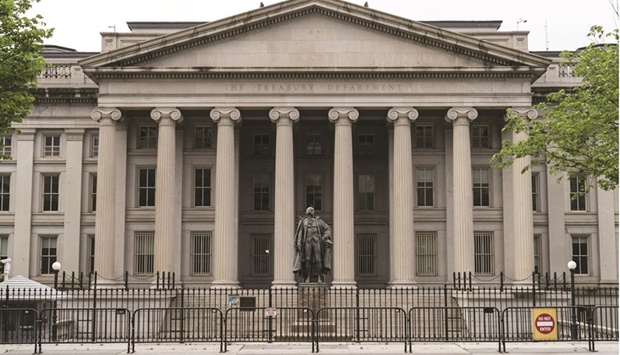The US Treasury halted the longest string of cutbacks to its quarterly sales of longer-term debt in about eight years, showcasing the end of a period of historic reduction in the fiscal deficit.
In a quarterly announcement on debt-management strategy released yesterday, the Treasury Department also said it plans further investigation into a potential program to buy back older securities, with findings to be shared in subsequent quarterly releases. Such operations could help to address continuing concerns about difficulty in being able to trade certain Treasuries.
A rapidly shrinking budget gap - thanks to the end of pandemic-relief spending and by an economic recovery that spurred record tax revenues - allowed the Treasury to reduce its so-called quarterly refunding auctions the past four times.
But a deteriorating fiscal outlook is now contributing to a bump in estimated borrowing needs. And the Federal Reserve’s continuing runoff of its portfolio of Treasuries is forcing the government to issue more debt to the public.
The Treasury said it will sell $96bn of long-term securities at its the quarterly refunding auctions next week. That’s in line with the August operation, after accounting for previously planned trims to two-year note sales. Dealers had widely predicted an unchanged total.
“Treasury believes that current issuance sizes leave it well-positioned to address a range of potential borrowing needs,” the department said. The Treasury didn’t offer any update on when it expects the federal debt limit to become binding on its operations.
The Treasury also said it’s investigating the idea of restarting a debt-buyback programme, something it hasn’t done in earnest since the early 2000s. Officials queried primary dealers on the topic last month. An advisory committee to the Treasury in August also analysed the possible benefits and structure of a fresh programme.
With liquidity in Treasuries this year waning as trading volumes and volatility surged in wake of the most aggressive pace of Fed tightening in decades, some strategists have said the Treasury buying back so-called off-the-run securities - debt that’s no longer a current benchmark - might help improve trading conditions.
“Treasury continues to meet with a broad variety of market participants in order to assess the costs and benefits associated with buybacks” and will “share its findings on buybacks as part of future quarterly refundings,” the department said. “Treasury has not made any decision on whether or how to implement a buyback program but will provide ample notice to the public on any decisions.”
Officials at the Treasury, Fed and other regulatory agencies have in the past year picked up the pace of efforts to boost resiliency of the world’s biggest debt market, which has been subject to periodic disruptions in recent years.
Among the steps under consideration is boosting data published about transactions in Treasuries. After gathering feedback from market participants, the Treasury “looks forward to further dialogue” on the issue at a gathering in New York scheduled for November 16.
Next week’s quarterly refunding auctions break down as follows:
$40bn of 3-year notes on November 8, compared with $42bn at the August refunding and $40bn at the October auction.
$35bn of 10-year notes on November 9. $21bn of 30-year bonds on November 10.
The refunding will raise about $40.7bn in new cash.
As also expected by several dealers, the Treasury announced yesterday it will boost sales of five-year inflation-linked securities as debt managers work to lift so-called TIPS as a share of total debt outstanding.
The specifics on TIPS, which compensate holders for increases in consumer prices - were as follows:
5-year TIPS December reopening increased to $19bn.
10-year TIPS reopening maintained at $15bn for November. 10-year TIPS January new issue in January maintained at $17bn.
Meantime, the Treasury refrained from any further cutbacks in the sales of 20-year bonds, which have struggled this year with dimmed levels of liquidity. After the release, the 20-year bond slightly underperformed its surrounding-maturity peers, in part given the hopes by some in the market for additional issuance cuts that didn’t pan out.
Separately, minutes of officials’ meeting with the Treasury Borrowing Advisory Committee, a group comprising dealers, investors and other stakeholders, showed that dealers saw risks for even bigger borrowing needs than expected.
“Risks to their borrowing estimates were to the upside, due to uncertainty around monetary and fiscal policy and the strength of the economy,” the minutes said. Another source of uncertainty was how long the Fed will keep up its current pace of bond-portfolio runoff. There was a $600bn gap in dealers’ interquartile range - the middle half of the forecasts - of predictions for the 2024 fiscal year, the minutes showed.

The US Treasury building in Washington, DC. The US Treasury halted the longest string of cutbacks to its quarterly sales of longer-term debt in about eight years, showcasing the end of a period of historic reduction in the fiscal deficit.


